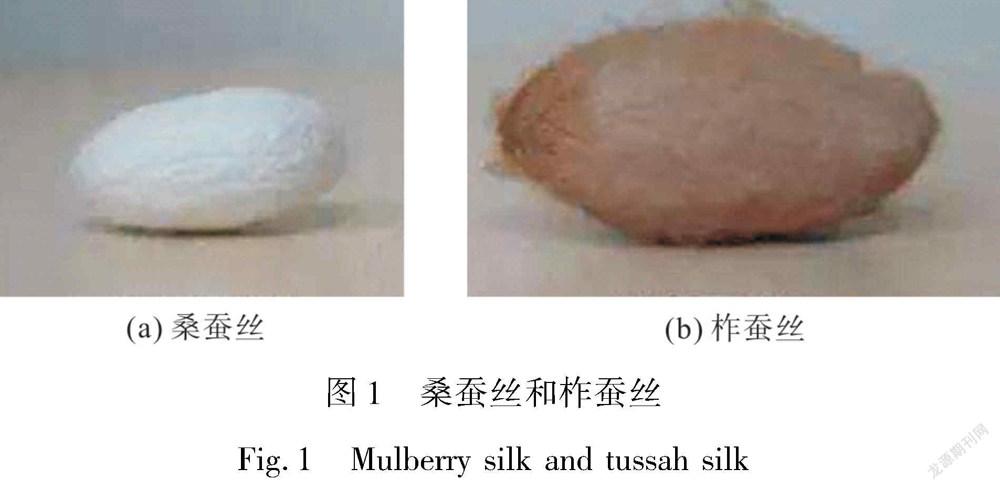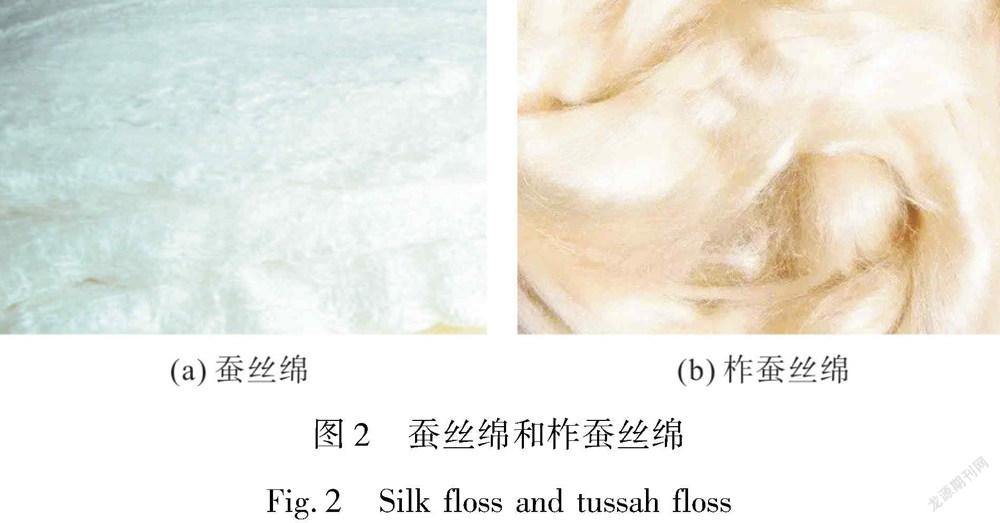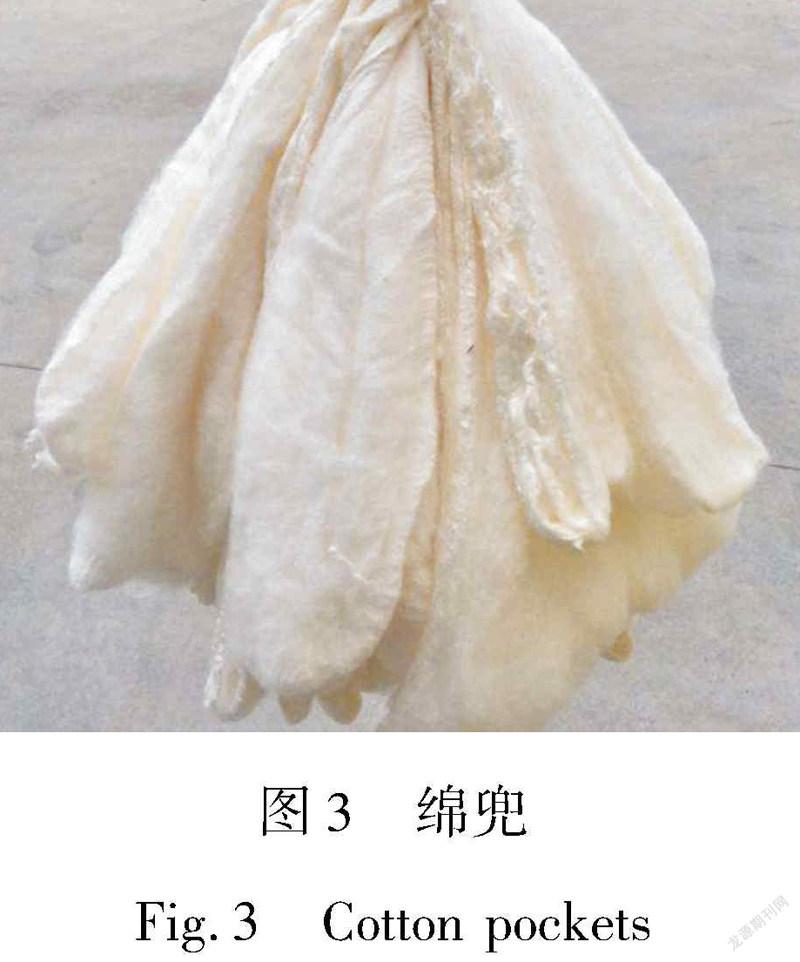标准解读:蚕丝绵纤维长度试验方法解析
2022-03-19张惠芳姚伟慧何波曹丽勤
张惠芳 姚伟慧 何波 曹丽勤



摘要:本文对国家标准GB/T 24252—2019《蚕丝被》中关于桑蚕丝和柞蚕丝两类丝绵长度的检测标准FZ/T 40009—2017《蚕丝绵纤维长度试验方法》进行解析,从丝绵分类、丝绵使用的原材料和生产工艺、丝绵的特征三个方面详细分析,归纳出五种丝绵长度鉴别定性的标准方法。通过对FZ/T 40009—2017检测标准进行解析和补充,可以进一步规范蚕丝绵及蚕丝被的检测方法并提高其产品质量。
关键词: 标准;蚕茧;丝绵;分类;长度;工艺;特征;鉴别
中图分类号: TS102.33
文献标志码: A
文章编号: 1001 7003(2022)03 0150 05
引用页码: 031401
DOI: 10.3969/j.issn.1001-7003.2022.03.020 (篇序)
蚕丝被产品作为一种天然绿色的产品,当下越来越为消费者所青睐。蚕丝被产业作为茧丝绸行业的一小类,近几年发展迅速,生产和销量逐年上升 [1] 。《蚕丝被》国家标准 GB/T 24252— 2019于2020年5月1日修订后开始实施 [2] ,决定蚕丝被价格和品质质量 [3] 的最重要的一个因素是丝绵的长度,新实施的GB/T 24252—2019《蚕丝被》标准增加了丝绵长度的考核指标。GB/T 24252—2019《蚕丝被》标准中丝绵长度的测试方法标准为FZ/T 40009—2017《蚕丝绵纤维长度试验方法》 [4-5] ,FZ/T 41003—2010《桑蚕绵球》和FZ/T 41004—2017《柞蠶绵条》。其中FZ/T 41003—2010《桑蚕绵球》和 FZ/T 41004— 2017《柞蚕绵条》为绢制丝绵的长度测试方法。标准实施一年多来,部分蚕丝被生产销售企业存在对标准不理解,未按标准正确标注丝绵长度,造成产品质量不符合新的蚕丝被标准的情况;部分检测机构则对蚕丝绵的生产工艺不熟悉,造成对丝绵长度误判情况,影响了蚕丝被质量的判定和评价 [6-8] 。生产销售企业如何理解统一丝绵长度,检测机构如何熟悉生产工艺正确鉴别和判定丝绵长度,本文重点按照FZ/T 40009—2017《蚕丝绵纤维长度试验方法》中蚕丝绵长度形态类别鉴定,结合各长度丝绵所用的原料 [9-10] 、生产加工工艺和丝绵特征进行丝绵长度鉴别的解析。
1 FZ/T 40009—2017《蚕丝绵纤维长度试验方法》标准分析
FZ/T 40009—2017标准对蚕丝绵长度形态类别鉴定分网状丝绵、絮状丝绵、网状丝绵和絮状丝绵混合丝绵三类,其丝绵的形态按照标准附录A,网状丝绵和絮状丝绵混合丝绵用目测分辨及手工分离,按照标准规定的网状丝绵和絮状丝绵进行鉴别。
1.1 网状丝绵
标准6.1.1条规定:经平面拉伸,蚕丝不易分离,目测蚕丝呈网状分布,蚕丝纤维切断很少,则可判定该丝绵为长丝绵。注:长丝绵一般以整只蚕茧或蛹衬为原料,经手工或机械开茧加工工艺制成。在实际检测中,手工和机械开茧存在鉴别困难,尤其是手工丝绵和蛹衬丝绵的鉴别。
标准6.1.2条规定:经平面拉伸后,目测蚕丝呈网状分布,蚕丝纤维绵块、绵点和断头较多,蚕丝纤维长度在200 mm及以上,则可判定该丝绵为网状中长丝绵。注:网状中长丝绵一般经机械开绵加工工艺制成。此条规定,对较薄的蛹衬开茧丝绵和开绵的网状中长丝绵的鉴别存在困难,对用茧衣开绵制成网状丝绵的长短存在无法确定的情况。
1.2 絮状丝绵
标准6.2.1条规定:经平面拉伸后,蚕丝易分离,目测蚕丝呈絮状,大部分蚕丝纤维长度在200 mm及以上,则判定为絮状中长丝绵。6.2.2条规定:经平面拉伸后,蚕丝极易分离,目测蚕丝呈絮状,大部分蚕丝纤维长度在200 mm以下,则判定为絮状短丝绵。注:絮状丝绵一般经机械梳绵加工工艺制成。对于絮状丝绵的鉴别,不存在难度问题。
标准比较简单地描述丝绵长度形态类别和加工生产工艺,存在三种蚕丝绵长度形态类别鉴别的难点:手工长丝绵和机制长丝绵的鉴别;开茧的蛹衬网状中长丝绵和开绵的网状中长丝绵的鉴别;开绵网状短丝绵和梳绵絮状短绵的鉴别。为此,本文结合各长度丝绵所用的原料、生产加工工艺和丝绵特征进行丝绵长度难点鉴别的解析补充。
2 丝绵生产加工工艺及特征
2.1 丝绵原材料
生产丝绵的主要原材料有蚕茧、茧壳、茧衣,以及制丝加工的副产品汏头、长吐、蛹衬、绢纺桑蚕丝绵球、绢纺柞蚕丝绵条等。其成分主要分两种,即桑蚕丝和柞蚕丝。桑蚕丝绵使用的原料为桑蚕茧和桑蚕茧加工副产品,桑蚕茧的颜色为白色;柞蚕丝绵使用的原料为柞蚕茧和柞蚕茧加工副产品,柞蚕茧的颜色为黄褐色,柞蚕茧明显比桑蚕茧大,如图1 所示。
2.2 丝绵分类
丝绵按纤维成分分桑蚕丝绵和柞蚕丝绵,桑蚕丝绵为白色,如图2(a)所示;柞蚕丝绵为淡黄色,如图2(b)所示。
丝绵按加工工艺分成手工丝绵和机织丝绵两类。手工丝绵是采用手工加工工艺制成的半成品绵兜,如图3所示。绵兜为再经人工拉伸伸展后的产品,手工丝绵为网状丝绵。机制丝绵是使用机械加工工艺生产的丝绵,分开茧丝绵、开绵丝绵和开梳丝绵三类。开茧丝绵为网状丝绵,开绵丝绵为网状丝绵,开梳丝绵为絮状丝绵。GB/T 24252—2019《蚕丝被》标准规定的绢制丝绵为开梳丝绵。
丝绵按照长度和形态分为长丝绵、中长丝绵和短丝绵三类。长丝绵为网状丝绵,中长丝绵有网状丝绵也有絮状丝绵,短丝绵为絮状丝绵。GB/T 24252—2019《蚕丝被》标准规定绢制丝绵为絮状短丝绵。
2.3 丝绵生产工艺及特征
2.3.1 手工丝绵
手工丝绵采用的原材料为蚕茧。手工丝绵基本使用桑蚕茧,无法进行缫丝的双宫茧茧大壳厚,是生产手工丝绵的优质原料。柞蚕茧由于其纤维刚性强、纤维粗,手工制作强度大,手工剥茧拉伸困难,基本不使用柞蚕茧。
其加工生产工艺:干茧(或鲜茧)→煮茧→手工剥茧→拉伸成绵兜→煮练除油脱胶(精炼)(加入碱及混合试剂进行去脂脱胶)→柔软洗涤中和(加入柔软剂、冰醋酸)→脱水→烘干或晾干→人工拉伸成网→叠加铺垫→长丝绵。
其特征:由多个绵兜拉成一张张薄薄的网叠加铺垫而成,基本无切断或断头,蚕丝绵有明显的叠加点,可以一张一张分离。手工蚕丝绵存在丝筋和绵块,无绵点。拉伸时,很好地保持均匀的网状,不会出现大量的断头。其手感柔软、细膩、光滑、弹性好,蓬松,色泽均匀自然,光泽柔和。
2.3.2 开茧丝绵
开茧丝绵使用的原材料为不破损的整个蚕茧和缫丝后的蛹衬茧,包含桑蚕茧、柞蚕茧和其他蚕茧。
其生产加工工艺:生茧(或鲜茧)→水煮抽丝卷绕在开茧机的滚筒上→截取滚筒上绵片→煮练除油脱胶(精炼)(加入碱及混合试剂进行去脂脱胶)→柔软洗涤中和(加入柔软剂、冰醋酸)→脱水→烘干→长丝绵。
其特征:用生茧生产的开茧丝绵基本无切断或断头,丝绵纤维粗细均匀,无绵点和绵块,基本无丝筋,拉伸时,很好地保持均匀的网状,不会出现大量的断头和成网不均匀的情况,手感柔软、细腻、光滑、弹性好,蓬松,色泽均匀自然,光泽柔和。蛹衬茧的开茧丝绵的特征是基本无绵点,但有绵块和丝筋,而且丝筋较多,拉伸时,会出现成网不匀或网断裂出现断头的情况,弹性、撕拉韧性和强力差。
2.3.3 开绵丝绵
开绵丝绵采用的原材料为桑蚕茧和柞蚕茧的茧壳、茧衣、汏头、长吐等。
其生产加工工艺:茧壳、汏头、长吐等→去除蚕蛹和杂 质→除 油脱胶柔软中和精炼地烘干→开绵机开绵→网状丝绵;茧衣→除杂质→开绵机开绵→网状短丝绵。
其特征:开绵丝绵由于使用机械针开松,把蚕丝纤维切断,因此存在较多的切断和断头,存在大量的打结纤维、绵点和未开松的绵块、丝筋。用茧壳等为原料或蚕丝纤维长度基本大于20 cm以上的蚕丝原料生产的开绵丝绵,为网状中长丝绵,未开松的绵块、丝筋多,能成网,拉伸时网容易断开,出现大量断头。用茧衣为原料或蚕丝纤维长度小于20 cm以下的蚕丝原料生产的开绵丝绵,不易成网,为短丝绵,打结纤维和绵点多,有绵块和丝筋,切断和断头多,色泽均匀度差,存在明显色差,蚕丝纤维不顺直,手扯绵片易分离;用茧衣生产的开绵丝绵还存在杂质较多、色泽较暗的情况,手感弹性和蓬松性能差。
2.3.4 梳绵丝绵
梳绵丝绵采用的原材料为开绵原料和绢纺桑蚕丝绵球、绢纺柞蚕丝绵条。
其生产加工工艺:开绵原料和绢纺桑蚕丝绵球、绢纺柞蚕丝绵条→梳绵(使用梳毛和梳棉设备)→絮状中长丝绵和(或)絮状短丝绵。
其特征:开绵丝绵的丝绵均匀分布,蚕丝纤维排列顺直,无丝筋和绵块,有打结纤维和绵点,无撕拉韧性,手扯绵片易分离,为絮状丝绵。蚕丝纤维长度基本大于20 cm以上的为絮状中长丝绵,絮状中长丝绵基本为柞蚕丝,柞蚕絮状中长丝绵具有比桑蚕长丝绵更好的蓬松度,手感柔软、细腻、光滑、弹性好,颜色为淡黄色,色泽均匀自然,光泽柔和。蚕丝纤维长度基本小于20 cm以下的为絮状短丝绵,绵点较多,其中5 cm以下的短纤维较多,手感弹性和蓬松性能差,色泽均匀 度差。
3 丝绵长度检测难点鉴别定性方法
本文结合FZ/T 40009—2017《蚕丝绵纤维长度试验方法》标准、丝绵加工工艺和特征,归纳以下五种丝绵长度检测难点的鉴别定性方法。
1) 手工长丝绵和机制长丝绵的鉴别定性
第1步:找切断、断头和撕拉绵片。如果丝绵基本无断头、撕拉韧性好,且基本不出现撕拉绵片纤维间移动断裂的情况,则定性为长丝绵。
第2步:找分层点。如果能找到分层点,通过手工分离出一层一层薄薄的网状长丝绵片,存在绵块、丝筋的长丝绵,则可定性为手工长丝绵;如果能分离出多层且比较厚的网状长丝绵片,或无法进行手工分离的,丝绵纤维粗细均匀,无绵块,基本无丝筋,则可定性为机制长丝绵。
2) 开茧蛹衬网状丝绵的鉴别定性
第1步:确定机制开茧蛹衬丝绵。丝绵中存在丝筋、绵块和绵点,撕拉绵片时,有较多的丝筋,有撕拉韧性,则可定性为机制开茧蛹衬丝绵。
第2步:撕拉绵片找蚕丝纤维的切断和断头。如果基本无断头,则定性为蛹衬长丝绵;如能查到较多的蚕丝纤维切断和断头,则定性为长丝绵+网状中长丝绵。
3) 开茧网状中长丝绵和开绵网状中长丝绵的鉴别定性
查丝筋、绵块、绵点和撕拉丝绵。如果绵点、丝筋和绵块较多,丝筋、绵块夹杂在丝绵中,与其他丝绵断开,丝筋和绵块容易扦出,撕拉绵片纤维间容易移动断裂,则可定性为开绵网状中长丝绵;如果无绵点,为软丝筋和软绵块,与其他丝绵有连接,丝筋和绵块不易扦出,撕拉绵片纤维间不易移动断裂,则可定性为开茧网状中长丝绵。
4) 网状中长丝绵和絮状中长丝绵的鉴别定性
第1步:目测丝绵纤维长度。丝绵纤维长度基本在20 cm及以上,则可定性为中长丝绵。
第2步:检查丝绵片的蚕丝纤维排列分布程度、丝筋、绵块、绵点及手扯绵片。如果丝绵纤维排列顺直整齐,有绵点但无丝筋和绵块,手扯绵片容易分离,则可定性为絮状中长丝绵;如果丝绵纤维排列杂乱不顺直,有绵点、丝筋和绵块,手扯绵片不易分离,则可定性为网状中长丝绵。
5) 开绵网状短丝绵和絮状短丝绵的鉴别定性
第1步:目测丝绵纤维长度。丝绵纤维长度基本在20 cm以下,则可定性为短丝绵。
第2步:检查丝绵片的蚕丝纤维排列分布程度、丝筋、绵块和绵点及手扦绵片丝绵。如果丝绵纤维排列顺直整齐,有绵点但无丝筋和绵块,手扯绵片容易分离,则可定性为絮状短丝绵。丝绵纤维排列交叉杂乱不顺直,有绵点、丝筋和绵块,手扦绵片丝绵中丝筋和绵块不易分离,则可定性为网状短 丝绵。
4 结 论
丝绵长度是蚕丝被产品等级和品质的重要衡量指标,GB/T 24252—2019《蚕丝被》标准分三个质量等级:优等品、一等品和合格品。标准规定:优等品和一等品的纯桑蚕丝被
的丝绵长度为长丝绵,纯柞蚕丝被的丝绵长度为长丝绵和中长丝绵;使用说明(标识)中的丝绵纤维含量应标注丝绵的蚕丝种类(桑蚕丝、柞蚕丝)和丝绵长度(长丝绵、中长丝绵、短丝绵和绢制丝绵);絮状中长丝绵和短丝绵需要有长度含量比例值。蚕丝被生产企业需要根据丝绵长度和长度含量比例值来确定产品的质量等级,所以对丝绵长度精准定性和定量检测对规范蚕丝被产品质量等级划分具有重大意义。
参考文献:
[1] 錢有清, 刘文全, 柳恩见. 中国茧丝绸行业2018年运行分析及2019年展望[J]. 丝绸, 2019, 56(7): 1-8.
QIAN Youqing, LIU Wenquan, LIU Enjian. Analysis on operation of Chinese cocoon silk industry in 2018 and prospect in 2019[J]. Journal of Silk, 2019, 56(7): 1-8.
[2] 伍冬平, 周颖, 李鹏, 等. 《蚕丝被》国家标准修订解析及实施建议[J]. 丝绸, 2020, 57(3): 1-6.
WU Dongping, ZHOU Ying, LI Peng, et al. Analysis and implementation suggestions on the revision of the national standard of Silk Quilt [J]. Journal of Silk, 2020, 57(3): 1-6.
[3] 裴付宇. 蚕丝被标准与质量探析[J]. 丝绸, 2013, 50(5): 28-32.
PEI Fuyu. Standard and quality of silk quilt[J]. Journal of Silk, 2013, 50(5): 28-32.
[4] 冯婧. 蚕丝被纤维长度量化检测技术及标准的研究[D]. 杭州: 浙江理工大学, 2015.
FENG Jing. Study on the Quantitative Detection Technology And Standard of Silk by Fiber Length[D]. Hangzhou: Zhejiang Sci-tech University, 2015.
[5] 王洋, 高丽, 毕玉洁. FZ/T 40009—2017《蚕丝绵纤维长度试验方法》标准介绍[J]. 中国纤检, 2019, 524(4): 95-97.
WANG Yang, GAO Li, BI Yujie. FZ/T 40009-2017 Standard introduction of test method for fiber length of silk floss[J]. China Fiber Inspection, 2019, 524(4): 95-97.
[6] 顾红烽. 蚕丝被产品质量指标的检测及评价[J]. 丝绸, 2019, 56(7): 1-8.
GU Hongfeng. Detection and evaluation on quality index of silk quilts[J]. Journal of Silk, 2019, 56(7): 1-8.
[7] 顾红烽. 蚕丝被产品质量评价体系的建立[J]. 中国标准化, 2012(10): 103-106.
GU Hongfeng. Establishment of produt quality evaluation system for silk quilt[J]. China Standardization, 2012(10): 103-106.
[8] 李莉. 蚕丝被丝绵品质检验判定的分析与研究[J]. 现代纺织技术, 2019, 27(3): 50-52.
LI Li. Analysis and research of quality test of silk floss of silk quilt[J]. Advanced Textile Technology, 2019, 27(3): 50-52.
[9] 姚穆. 纺织材料学[M]. 北京: 中国纺织出版社, 2009.
YAO Mu. Textile Materials[M]. Beijing: China Textle Press, 2009.
[10] 黄继伟, 赵树强, 宁晚娥, 等. 木薯蚕丝纤维的热学性能研究[J]. 丝绸, 2018, 5(8): 7-11.
HUANG Jiwei, ZHAO Shuqiang, NING Wan’e, et al. Research on thermal properties of cassava silk fiber[J]. Journal of Silk, 2018, 5(8): 7-11.
Standard interpretation: Analysis on the test method for fiber length of silk floss
ZHANG Huifang, YAO Weihui, HE Bo, CAO Liqin
(Zhejiang Light Industrial Products Inspection and Research Institute, Hangzhou 310018, China)
Abstract:
As unique traditional products in China, silk quilts are of high prices among quilts. They are deeply loved by consumers for their unique qualities and advantages such as being close-fitting,warm, fluffy and soft, breathable and healthful. With the increasing costsof raw materials and labor, the production costs of enterprises also increase, so some enterprises use low-quality raw materials as high-grade and high-quality products to improve the profit margin. There emerge a series of undesirable phenomena such as simulating medium-long silk floss with short silk floss, simulating long silk floss with medium-long silk floss, and simulating high-quality doupion long silk floss with low-quality pelettes long silk floss, as well as the phenomenon of adding chemicals to silk floss, and offering shoddy and fake commodities, which has seriously reduced the quality of silk quilts. The most important factor in judging the price and quality of silk quilts is the length of silk floss. The original national standard GB/T 24252-2009 for silk quilts neither quantifies the length index of silk floss in the quality of silk quilt nor limits the added chemical substances. Therefore, relevant departments have revised the national standard for silk quilts. The newly implemented standard GB/T 24252-2019 for silk quilts adds the assessment index of the length of silk floss. Since the implementation of the standard, some manufacturing and marketing enterprises of silk quilts do not understand the standard and fail to correctly mark the length of silk floss according to the standard, resulting in the product quality being not qualified for the new silk quilt standard. Some testing institutions are unfamiliar with the production process of silk floss, resulting in misjudgment of the length of silk floss, and affecting the judgment and evaluation of the quality. It is of great importance for enterprises to understand and unify the length of silk floss and for testing institutions to be familiar with the production process and correctly identify and determine the length. This paper analyzes the length detection of mulberry silk floss and tussah silk floss in the national standard GB/T 24252-2019 for silk quilts and the industrial standard FZ/T 40009-2017 test method for fiber length of silk floss. Through the analysis of the standard FZ/T 40009-2017 test method for the length of silk floss, this paper points out the difficulties in the identification of three types of silk floss length forms in the standard: the identification of man-made long silk floss and machine-made long silk floss; the identification of the reticular medium-long silk floss from the pelettes of opened cocoon and that from waste silk opening; the identification of reticular short silk floss and combed floc short silk floss. Combined with the raw materials, production and processing technology and characteristics of the length of silk floss, the difficult points of silk floss length are identified, analyzed and supplemented. Through the detailed analysis of the classification of silk floss, the raw materials and production technology used for silk floss and the characteristics of silk floss, five standard methods for the identification and characterization of silk floss length are summarized. With the continuous improvement of people’s living standards and demands, high-quality, high-performance and high-price silk quilts will enter ordinary people’s homes. Through the analysis of the quality grade, silk type and silk floss length quality of silk quilts, it is found that the higher grade of silk quilts, the longer the silk floss, the better the quality, the higher the price and the better the consumer experience. The analysis and supplement of silk quilt standards in this paper provide technical guidance for manufacturing and marketing enterprises to understand the silk quilt standards and correctly mark the length of silk floss. It can also help inspection institutionsget familiar with the production process, correctly identify and judge the length of silk floss, and help consumers purchase high-quality silk quilts at reasonable prices.
Key words:
standard; cocoon; floss silk; classification; length; production process; characteristics; identification
3471500589235
